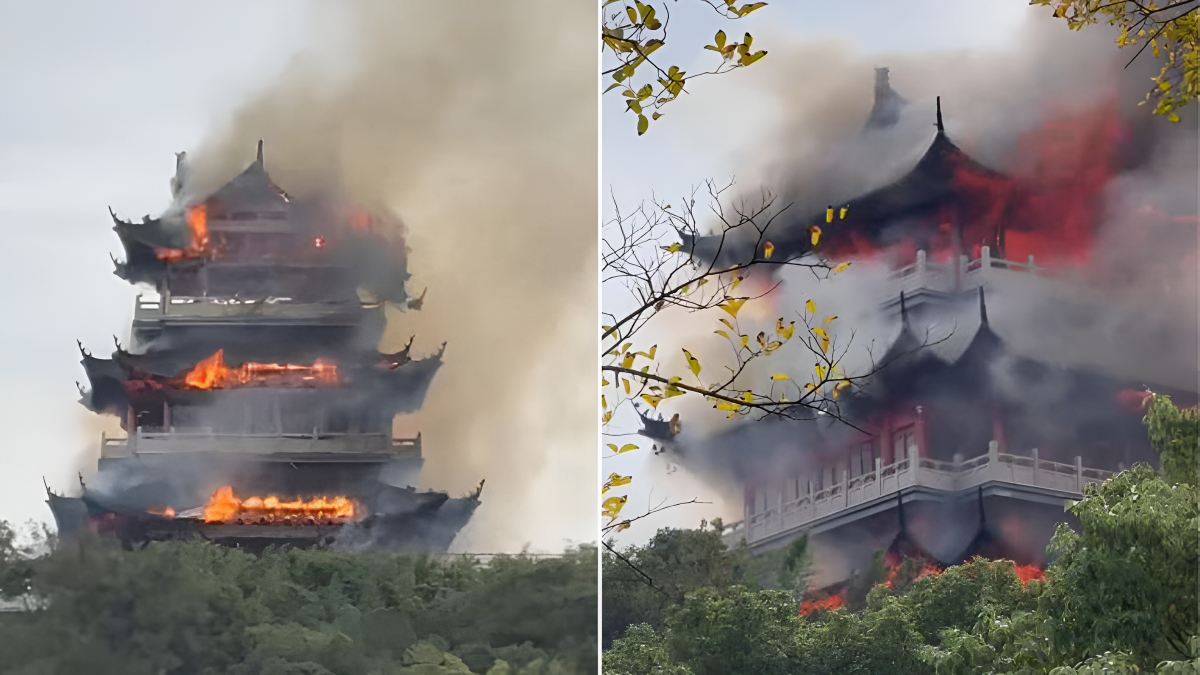Now Reading: Tourist’ Candle Sparks Inferno at Chinese Temple
-
01
Tourist’ Candle Sparks Inferno at Chinese Temple
Tourist’ Candle Sparks Inferno at Chinese Temple

November 20, 2025: A shocking incident of tourist negligence has led to the near-total destruction of a Chinese temple pavilion, with dramatic video footage of the towering inferno quickly circulating across global social media platforms.
The blaze, which erupted on November 12 at the Wenchang Pavilion on Fenghuang Mountain in Zhangjiagang, Jiangsu province, has been attributed by local authorities to the “irresponsible” handling of ceremonial candles and incense by a visitor.
The Incident and Viral Footage
The three-storey wooden pavilion, which is managed by the neighboring Yongqing Temple, was rapidly engulfed by flames. Eyewitness accounts and the widely shared viral video capture the terrifying speed with which the fire consumed the structure. Thick, black smoke is seen billowing high into the sky, obscuring the mountain backdrop, while large sections of the traditional wooden roof framework crash to the ground. The sheer scale of the fire has stunned observers both locally and internationally.
Fortunately, local officials confirmed that no casualties were reported, and the quick response by fire fighting teams successfully contained the blaze, preventing it from spreading to the surrounding forested area.
Cause of the Catastrophe
Preliminary findings from the official investigation point directly to the improper use of devotional items by a tourist. In Chinese temples, the lighting of candles and incense is a common and important part of worship. However, the use of these open flames requires strict adherence to safety protocols, especially in traditional wooden structures.
The local Zhangjiagang city authorities released a statement indicating that the fire was sparked by the visitor’s careless actions, underscoring the severe risks associated with fire hazards in such culturally significant, often combustible, environments.
The Pavilion’s Significance and Loss
While initial reports mistakenly suggested the burned structure was a 1,500-year-old relic, authorities clarified that the Wenchang Pavilion was a modern construction, built between 2008 and 2009. Crucially, the structure did not house any irreplaceable ancient relics or artifacts, which has offered a small measure of relief to the community.
Nonetheless, the Wenchang Pavilion was a well-loved cultural and spiritual landmark, popular with both pilgrims and tourists. The site itself is historically significant, being part of the wider complex of the Yongqing Temple, which traces its origins back many centuries. The destruction of the modern pavilion is still viewed as a tragic loss of traditional-style architecture and a setback for the spiritual site.
Also Read: Tragic Loss in Vasai: Student Dies After Alleged Corporal Punishment; Teacher Arrested
Accountability and Future Safety
The shocking event has ignited a critical conversation online about tourist responsibility and the need for improved fire safety measures at cultural and religious sites globally. Many social media users expressed sadness and anger, calling for greater caution and respect from visitors.
Local authorities have pledged to pursue accountability based on the final investigation findings. They also confirmed that once the probe is complete, plans will be made to rebuild the Wenchang Pavilion in its traditional architectural style. Furthermore, the temple management will be required to strengthen safety measures to prevent similar catastrophic incidents in the future.










